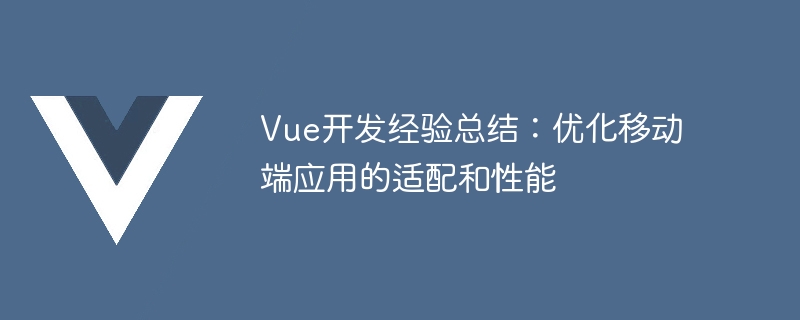Home >Web Front-end >Vue.js >Summary of Vue development experience: Optimizing the adaptation and performance of mobile applications
Summary of Vue development experience: Optimizing the adaptation and performance of mobile applications
- WBOYWBOYWBOYWBOYWBOYWBOYWBOYWBOYWBOYWBOYWBOYWBOYWBOriginal
- 2023-11-23 10:39:141463browse

Vue is a popular JavaScript framework that is widely used to develop modern mobile applications. This article will summarize my experience in Vue development, mainly focusing on optimizing the adaptation and performance of mobile applications.
In mobile application development, adaptation is a key issue. Different mobile devices have different screen sizes and resolutions, so it's important to ensure that your app displays well on a variety of devices. The following are some adaptation strategies I use in Vue development.
First, I used Vue’s responsive layout library, such as Vuetify or Element UI, to implement adaptive layout for mobile applications. These libraries provide a rich set of components that can automatically adjust the layout according to the screen size, making the application highly compatible on different devices.
Secondly, I used rem units to set the font size of mobile applications. rem units are calculated relative to the root element's font size, so they can be dynamically adjusted based on the device's viewport size. Screen size adaptation can be achieved by setting the font size of the root element to one-tenth of the device width.
In addition, for different mobile devices, I also used media queries to set different styles for different screen sizes. By using @media rules in CSS, you can apply different styles according to the screen width and height of the device, thereby realizing the adaptation of mobile applications.
In addition to adaptation, performance is also an aspect that needs attention in mobile application development. Here are some performance optimization strategies I employ in Vue development.
First, I used Vue’s lazy loading function to delay loading images and other resources in the page. When the page scrolls to the visible area, only the resources in that area will be loaded, thus reducing initial load time and bandwidth consumption.
Secondly, I introduced Vue components on demand instead of introducing all components at once. By using dynamic import syntax, components can be loaded dynamically on demand, reducing the initial load time of your app.
In addition, I also optimized the code of the Vue application to reduce unnecessary re-rendering and re-calculation. By using Vue's computed attribute and watch attribute, you can cache data and avoid unnecessary recalculation, thereby improving application performance.
Finally, I used Vue’s virtual list function to optimize the rendering performance of long lists. A virtual list will only render list items within the visible area instead of rendering all list items at once, thus reducing rendering time and memory consumption.
In summary, through appropriate adaptation and performance optimization strategies, mobile applications developed by Vue can have good compatibility and performance on different devices. I hope the experience summary in this article will be helpful to Vue developers in mobile application development.
The above is the detailed content of Summary of Vue development experience: Optimizing the adaptation and performance of mobile applications. For more information, please follow other related articles on the PHP Chinese website!
Related articles
See more- Detailed graphic explanation of HTML5 network topology diagram performance optimization
- Introduction to methods for optimizing and improving SQL performance
- Practice (1)--MySQL performance optimization
- Collect these Vue project performance optimization methods and you will be able to use them one day!
- Nginx performance optimization and security settings

